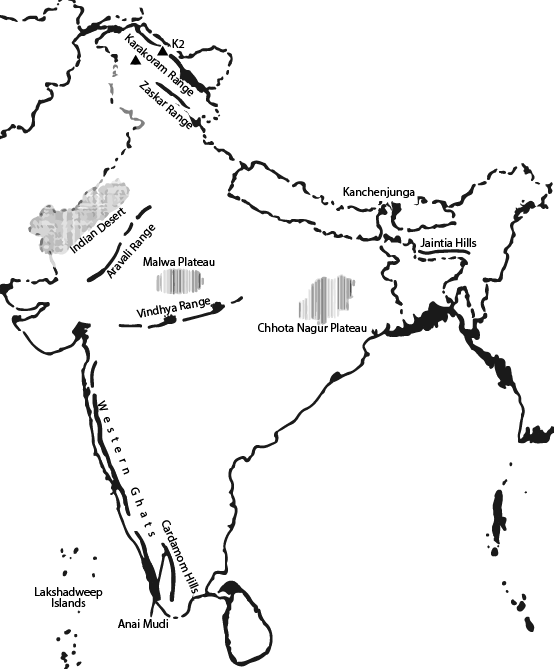NCERT Solutions for Class 9 Geography Chapter 2 Question Answer - FREE PDF Download
NCERT Solutions for Class 9 Social Science Geography Chapter 2 Physical Features of India
FAQs on NCERT Solutions for Class 9 Social Science Geography Chapter 2 Physical Features of India
1. What are the Outcomes of Learning Geography Chapter 2 Physical Features of India Class 9?
Chapter 2 Geography Class 9 helps students to be able to identify the different terrains present in our country. You can even learn how to point out the different topographic features on the map of India. The chapter provides students with detailed knowledge about the peaks of the Himalayas including Mt. Everest, Nanga Parbat, Kanchenjunga, etc. The chapter also briefly describes the Northern Plains of India, its properties, areas, how they are spread and the rivers that flow through them. Students can also learn about the islands, coastal regions, etc. in detail.
2. What are the Contents of Class 9th Geography Chapter 2?
Class 9 Geography Chapter 2 Physical Features of India consists of the major physiographic divisions of the country India. India is a country which comprises of different types of physical terrains. The diversity of landforms of India makes the country special in terms of the geographic features. The different physiological divisions of our country are as followed:
The Himalayan Mountains
The Northern Plains
The Peninsular Plateau
The Indian Desert
The Coastal Plains
The Islands
Students will get a detailed idea of the above topographic features of India in the Class 9th Geography Chapter 2. At the ending of the chapter, students will able to locate these divisions in the map of India.
3. Is it difficult to score well in Chapter 2 Physical Features of India Class 9 Geography?
Students shall not face any difficulty in scoring well in Chapter 2 Physical Features of India of Class 9 Geography if they read the chapter thoroughly and make notes out of all the important information. This will help students easily answer all types of questions in the exam. Make sure to practice writing various definitions and remember examples. It is important to reach out to teachers for any doubts or queries. You can also take the help of NCERT Solutions available on the official website of Vedantu or download the Vedantu app where these solutions are available free of cost. They have been written by subject matter experts and are 100% reliable.
4. Where can I find NCERT Solutions for Chapter 2 of Class 9 Geography?
NCERT Solutions are an important part of the preparation for the Chapter 2 Physical Features of India of Class 9 Geography. Referring to NCERT Solutions can help students be able to comprehend the questions and write well-explained answers in their exams. Vedantu provides students with in-depth answers framed on the basis of the latest syllabus provided by CBSE.
5. Name some other important chapters apart from Chapter 2 Physical Features of India of Class 9 Geography?
All the chapters are equally important and it is important to pay attention to all the chapters to score good marks in the Class 9 Geography exam. The NCERT book prescribed by CBSE for Class 9 Geography is known as Contemporary India. The book contains a total of six chapters that have been covered in the NCERT Solutions for Class 9 Social Science. These chapters are:
Chapter 1 - India- Size and Location
Chapter 2 - Physical Features of India
Chapter 3 - Drainage
Chapter 4 - Climate
Chapter 5 - Natural Vegetation and Wildlife
Chapter 6 - Population
6. How many questions have been covered in NCERT Solutions for Chapter 2 of Class 9 Contemporary India?
NCERT has provided students with a total of seven questions for Chapter 2 - Physical Features of India. NCERT Solutions for Chapter 2 of Class 9 Contemporary India covers all seven questions with well-explained solutions for each question. In addition to the seven questions, the NCERT also includes a question based on Map Skills which has also been covered by NCERT Solutions provided by Vedantu.
7. Which are the most important topics to prepare in NCERT Solutions for Geography Class 9 Chapter 2?
There are some important topics covered in Chapter 2 - Physical Features of India provided in Class 9 Geography NCERT. Students shall read about these topics thoroughly and make notes to increase the possibility of scoring full marks in your Geography exam. The important topics in Chapter 2 of Class 9 Geography include Formation of Landforms, the Northern Plains, the Himalayas, the Peninsular Plateau, coastal plains, islands, and the Indian Desert.
8. What are some key points to focus on while studying Class 9th Geography Chapter 2 Question Answer?
Students should focus on the characteristics and formation processes of each physical feature, the geographical distribution of these features, and their impact on climate, vegetation, and human activities. Understanding these aspects is crucial for a comprehensive grasp of the chapter.
9. Are there any important diagrams or maps to study in NCERT Class 9 Geography Chapter 2?
Yes, maps showing the distribution of major physical features are important. Students should practise identifying and labelling these features on maps as map-based questions are a significant part of the exams.
10. Why is it important to study the physical features of India Class 9?
Understanding the physical features of India is crucial because it helps in comprehending the country's geographical diversity, climatic conditions, natural resources, and how these factors influence human activities, agriculture, and settlement patterns.














 Watch Video
Watch Video















